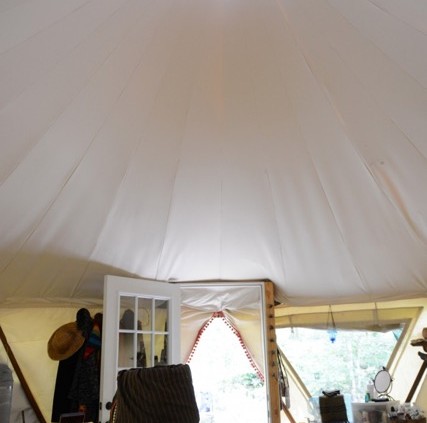My Roof Insulation
Hello, Yome Ponderers,
This is Jeremy again, here to share some of my experiences with the types of insulation we have available for our Yomes. Today I will discuss life with and without our roof insulation.
See, I have lived through five winters in the mountains of Western North Carolina in a Yome, and I have lived in them with no insulation, roof insulation only, roof and floor insulation, and finally with side wall insulation. I feel like I can give an honest assessment. We want our customers to have realistic expectations and be happy with their product.
My first winter was spent on a 20 foot by 20 foot deck, standard treated decking with gaps between boards. It was pretty drafty, mainly from the floor. I ended up covering the floor with thick paper and rugs here and there, and that’s all! Believe it or not, I stayed warm most of the time, with my cheap “Boxwood” wood stove and plenty of locust firewood. I could have bought insulating strips to better seal the transition between the sidewalls and roof, but the roof insulation package serves the same purpose, as noted below.
For my second winter in my Yome, I bought roof insulation, as it is the most effective place to insulate. There are two components, radiant barrier and the treated canvas covering. The radiant barrier is cut into triangular panels that fit between the roof poles and attach to the central tension ring in the center of the ceiling, where the vent is located (Septa and OctaYomes only). The covering also hangs from the tension ring, hiding the radiant barrier. There is a hole in the center of the covering where the vent is: it can be left open or covered with a velcro-edged circle of radiant barrier and canvas. The cover hangs below the roof poles and attaches to the top of the sidewalls with velcro. This makes a nice seal against the wind where the side walls meet the roof.
This made a big difference immediately. I could actually feel the radiant heat from the wood stove reflecting back from the ceiling. It was less drafty and more cozy, and I was content with this level of insulation for another winter. This is the most simple and cost effective way to improve your efficiency. I should also note that the radiant barrier also keeps a lot in keeping the Yome cooler in the summer sun.
Follow these links for more about options for insulating the deck (the next most useful step) and my experience with using our sidewall insulation


I’m glad to find your site, especially reading your experience with insulation options and an honest opinion. I hope to read about how things changed with the sidewall insulation!